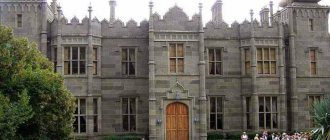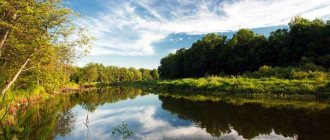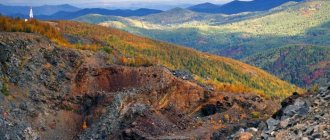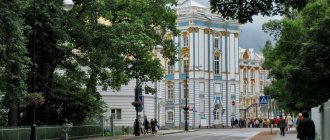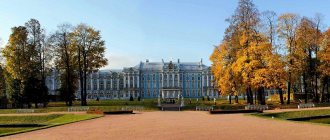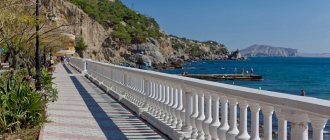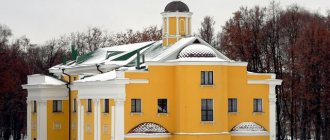Peterhof - perhaps the most famous suburb of St. Petersburg. As soon as it is not called: the Russian Versailles, the city of palaces, “the jewel in the crown of St. Petersburg,” the fountain capital of the world, an example of landscape art, and so on... The first mention of Peterhof dates back to 1705. What to see in Peterhof? It's very many incredibly beautiful sights, so it’s worth setting aside at least one full day to visit this amazing place.
During the Great Patriotic War, Peterhof was occupied by the Germans, who destroyed it almost completely. , more than 8 thousand exhibits and statues were evacuated . In the post-war years, a global reconstruction of the ensemble began, which continues to this day.
Peterhof is usually divided into Old and New . Old Peterhof is the western part of the city, where the estates of the Leuchtenbergskys and P.G. Oldenburgskys are located. New Peterhof is the eastern part, located between the Upper Garden and Alexandria Park.
What to see in Peterhof: 10 most beautiful sights
Large cascade of fountains, Samson fountain
Anyone who sees the 250-fountain Grand Cascade for the first time with its sculptural frame of 64 images and will not remain indifferent, because it is not just an object of art and some kind of aesthetic pleasure, but also a historical example of greatness and beauty, created by the artists and craftsmen of their time. The figure of “Samson” represents Russia, which defeated Sweden in the long Northern War, which allowed the country, under the leadership of Peter the Great, to reach the Baltic Sea and “cut a window to Europe.” Then Peterhof became an imperial residence, which was formed, designed and built by the best European and Russian architects following the model of the Versailles regular park. Today the Grand Cascade is the artistic embodiment of Peter’s dream of Great Russia, which he built and bequeathed to his descendants.
Dozens of gilded figures and a fountain extravaganza, making you forget about the bustle of the world, do not let you go and you want to immerse yourself again and again in the sound of water and the shine of drops on the gold of sculptures framed by the majestic buildings of the Great Peterhof Palace, rising on the terrace above the Great Cascade. It also contains grottoes, which in appearance cannot be distinguished from natural ones. The Great Cascade is fed from the Square Ponds of the Upper Garden thanks to an engineered water supply system that has existed for three centuries.
All this brilliance was created by various architects and sculptors: I. Braunstein, J.-B. Leblon, N. Michetti, M. G. Zemtsov, F. Vassu, K. Osner, among whom it is worth highlighting B. Rastrelli, who first created the figure of Samson in 1735. The hydraulic structures were carried out under the guidance of engineers P. Sualem, Tuvolkov, brothers Barratini. In 1802, sculptor M. Kozlovsky and architect A. Voronikhin created a new composition to replace the dilapidated one. In 1947, Samson was again put in his place by sculptors N. Mikhailov and V. Simonov, who created a copy from drawings and photographs. In 2011, the updated Samson, after restoration, again began to attract the attention of numerous visitors to Peterhof.
Sights of Peterhof
And now a little history. Petrodvorets was founded in 1710 and was intended as the main summer imperial residence . The idea of creating a country residence came from Peter I; he wanted it to be as luxurious as the French Versailles.
The surviving drawings of the tsar allow us to assert that the general concept of the layout, and in some cases the detailed design of some structures, belonged to the founder of Peterhof himself. The speed of creating the residence was amazing. Already in August 1723, the grand opening of Peterhof .
So what is it that captivates the imagination of Peterhof visitors?
The palace and park ensemble of Peterhof and its fountains
Not only the fountains are unique, but also the gravity water supply system, which has existed since the beginning of the 18th century. This is the world's largest system of fountains and water cascades . One of the largest architectural and fountain structures in the world is the Great Cascade of Peterhof - 250 sculptures and bas-reliefs, 80 fountains. In the center of the composition are two grottoes, on both sides of which there are waterfall stairs decorated with statues and vases.
The main fountain of the cascade is the Samson Tearing the Lion's Mouth fountain. During the Second World War, this sculpture was lost and restored from photographs in 1947 . The large cascade, as conceived by Peter I, symbolized the victory of Russia over Sweden (a lion is depicted on the coat of arms of Sweden) and served as the ceremonial end of the sea entrance to the residence.
What to see in Peterhof: the most beautiful sights 11
An interesting fact is that many of the craftsmen working on the ensemble had no idea what sea creatures looked like, so dolphins, for example, look more like fairy-tale fish.
Recently, the Upper and Lower Grottoes , created to strengthen the mountain on which the main fountain ensemble and the Grand Palace are located, have been open to the public. The interior decoration of the grottoes is unusual and beautiful; in tsarist times, hosts and guests rested here .
In the Lower Grotto there are “splash table” and “water curtains” joker fountains. The 12-meter wide Sea Canal begins from the Grand Cascade. There are 22 fountains along the canal, forming the so-called Alley of Fountains. Today, the Sea Canal and the Alley of Fountains are fully operational.
What to see in Peterhof: the most beautiful sights 12
The joker fountains of the Lower Park are very popular among guests . Funny fountains were installed by the will of Peter I. “Sofa” in the Monplaisir Garden, “Water Road” at the Roman fountains. Later, during the time of Catherine, the “Umbrella”, “Herringbone” and others fountains appeared.
Each fountain of Peterhof is a work of art and deserves a whole story; you can verify this during a personal visit. Of course, to enjoy the splendor of the fountains, it is better to visit Peterhof during the season when the fountains are operating. They usually open in mid-May and close in mid-October . It won't be difficult to check the schedule.
Great Peterhof Palace
The first two-story version of the Grand Palace was designed by J. B. Leblon, N. Michetti and I. Braunstein. Then it was called “Upper (mountain) chambers.” The width of the building at that time was equal to the Grand Cascade and was built from 1715 to 1725. In 1732, according to the design of M. Zemtsov, two galleries were added to the palace. The work was continued by B. Rastrelli in 1745-1755. The building became one floor higher and expanded along the terrace, bordering the Upper Park and the Lower Park. The Grand Palace was built in the style of “Russian” or “Elizabethan” Baroque, although initially it was more reminiscent of “Petrine Baroque”, like the Hermitage and Monplaisir palaces. The palace became the center of the Lower Garden, from which radial alleys radiate, designed by the master of landscape architecture J.B. Leblond, modeled on the parks of Versailles.
The splendor and luxury of the Baroque gave way to more austere decoration at the end of the 18th century. This was due to the fashion for classicism at the court of Catherine the Great. Many rooms of the palace were rebuilt in a new way: the Chesme Hall, the Dining Room, the Throne Room, the Chinese Cabinets (architect J. B. Vallin-Delamot). The interior decoration has undergone changes more than once. In the middle of the 19th century, the architect I. Stackenschneider created a project for the third floor of the Eastern wing, coming up with eight new interior options. Since this work was dedicated to the wedding of Nicholas I of Olga, half of the Grand Palace is still called Olginskaya.
The Grand Palace today has about 30 rooms and halls, many of which have been restored and are available for viewing by tourists. Here you can see with your own eyes the changes of eras, imagine how the royals lived with their entourage, how ladies and gentlemen from high Russian society danced at balls and walked along the palace.
List of places
Great Peterhof Palace
The main palace of Peterhof is a beautiful royal residence located in a picturesque park. Over several centuries, the building was rebuilt more than once to meet modern architectural trends. The first project was built by order of Peter I and in accordance with his preferences, so it looked quite simple. Under Elizabeth, new decorative elements were added, pomp and elegance appeared, dating back to the late Baroque. Perestroika was carried out by Rastrelli, also known for the projects of the Winter Palace and Smolny Cathedral.
Under Nicholas I, classicism was in fashion, and new classical elements were added both in the interior and exterior. However, most experts assess the numerous restructurings as successful. The best architects were always involved in working on the appearance of the palace, who managed to create a harmonious image that successfully combines the best of historical eras.
However, the modern building is a reconstruction restored almost from scratch. The palace was badly damaged during the Great Patriotic War, when after an explosion only the walls remained of the historical building. For twenty years, restorers restored the façade and all the interiors, which have now been restored to their original appearance.
Upper Park
The Upper Park is located in front of the Peterhof Palace and once served as the main entrance. That is why the best architects of St. Petersburg of that time were involved in its design, including Jean-Baptiste Leblond and Bartolomeo Rastrelli. The entire composition of the garden is in harmony with the architecture of the Grand Palace: with a central axis where fountains are symmetrically located, a geometric layout of alleys with bushes and trees. The composition is completed by the sculpture “Neptune” in the center.
This is an excellent place for walks and photographs, where it is worth stopping by to admire the sculptures, rest in the gazebo, hide in the shade of fruit trees and look at the carefully planned layout of the park and landscape composition. Unlike the Lower Park, entrance to the Upper Garden is free.
Large cascade of fountains
Now it is difficult to imagine that such a technically complex structure, looking so elegant and picturesque, was created back in the early 18th century. The cascade was conceived as a kind of ceremonial pedestal in front of the palace - this idea belonged to Peter I. Gilded sculptures were located on the steps, the main one of which is Samson tearing the jaws of a lion. The entire composition is an allegory of the military power of Russia, which has won access to the sea, and the cascade itself represents the transition from the palace to the Gulf of Finland.
During the war, many of the statues were stolen or destroyed, so they, including Samson, had to be restored from scratch. Now the entire architectural and sculptural ensemble has been restored to its original appearance and continues to function. The fountains work in the warm season, and in winter you can simply admire the sculptural composition.
You can look at the Cascade from the inside and learn about the history of its creation in the grotto of the Great Cascade.
The trip will be more eventful if you use the services of an individual guide who will tell you the most interesting things about the history of Peterhof and show the main points in one walk. You can choose a suitable route and order it using the link: Excursions in Peterhof.
Lower Park
In the Lower Park there are the main places of attraction in Peterhof: the Great Cascade of Fountains, the Peterhof Palace, the Marly and Monplaisir Palaces, access to the sea. In itself, it is a monument to palace and park art, modeled after the best parks in France in the 18th century. The thoughtfulness of the layout is striking, which has remained unchanged: at the end of each of the alleys there will be a palace or a fountain, and on each hill there will be a cascade. It is worth investing a lot of time to see all the palaces, pavilions and fountains.
Palace of Marly
The small and elegant Marly Pavilion stands on the banks of two ponds and was built as a guest house. The project was inspired by the pavilions of French royal residences. After the death of Peter I, “Marly” turned into a memorial museum for the emperor, which it still remains. The exhibition features his personal belongings, clothes and books.
Monplaisir Palace
Like other buildings in the Lower Park, Monplaisir and the adjacent garden were planned personally by Peter I. The influence of Dutch architecture is noticeable in the architecture of the residence, and the interiors are decorated with Western European paintings. It is believed that this was one of the favorite places of the emperor, which, like Marly, after his death acquired rather a memorial character, and now remains a museum.
Flickr/GooDCoFF
Large greenhouse
The greenhouse was built simultaneously with other buildings in the Lower Park, and due to its magnificent decoration it can also be mistaken for a palace. Rare exotic flowers and seedlings were stored in the greenhouse, and in winter it was used as a greenhouse. Now the greenhouse is occupied by a restaurant.
Flickr/GooDCoFF
Cascade "Chess slide"
Several cascades of fountains and “crackers” are scattered throughout the Lower Park. In the eastern part there is the “Chess Hill”. The tiles of its steps are paved in a checkerboard pattern, and on the sides there are marble sculptures of ancient gods on pedestals. Before the occupation, the statues were removed and buried underground to avoid destruction.
Roman fountains
The Roman fountains are a copy of the fountains in Rome, located in the square in front of St. Peter's Basilica. These are two-tiered symmetrical fountains that fit well into the square in front of the “Chess Hill”.
Cracker fountains
Cracker fountains are one of the favorite places of all visitors to the Lower Park. Some of them are hidden to suddenly shower unsuspecting people with jets of water. Now the effect of surprise is only partially effective, because these fountains are turned on at a strictly defined time, and a crowd always gathers around them. However, they are unique in their own right. Indeed, despite the widespread popularity of such entertainment in Europe in the 18th century, the Peterhof fountains are the only ones that have survived and are still in operation.
Lion Cascade
The lion cascade at the Hermitage pavilion was also inspired by ancient designs: columns with pilasters around the pool, bronze statues of guard lions and a statue of Aganippe, which, according to legend, inspires poetry.
Flickr/GooDCoFF
Grottoes of the Grand Cascade
The grottoes are located under the Great Cascade of Fountains and were designed by order of Peter I. The paved grottoes are decorated with gilded sculptures, vases and bas-reliefs. In the Lower Grotto, brickwork from Peter's times has even been preserved. You can get inside only with a guided tour, which will also tell you in detail about the mechanism of the fountains, the history of their creation and the long construction process.
Hermitage Pavilion
Small pavilions, called “Hermitages,” were built for relaxation and privacy. The Peterhof Hermitage was built even earlier than the St. Petersburg Hermitage, by order of Peter I. Feasts and important business meetings were held in the pavilion. It was possible to climb to the second floor only in a special chair on cables.
Like most buildings, it was badly damaged during the war, and the Germans kept guns in the luxurious halls. Now there is a museum exhibition inside.
Access to the Gulf of Finland
You can get to the shore of the Gulf of Finland in Peterhof in several places. The most popular point is in the Lower Park at the end of the central alley along the Sea Canal. Lakhta and the Kronstadt Naval Cathedral will be visible in the distance.
Another point is located to the left of Oldenburg Park near the lighthouse (59.899050, 29.867570) - there will be a small beach there.
Alexandria Park
The Alexandria park ensemble was conceived as a personal imperial residence and was named in honor of Alexandra Feodorovna, the wife of Nicholas I. It is quieter than the neighboring complexes, but all the alleys are well-groomed and the original layout remains the same. During the war, many buildings were damaged, but many interesting points remained. The most famous of them is the beautiful pseudo-Gothic chapel (59.880614, 29.931022), which is occupied by the Orthodox Church.
Another neo-Gothic building is the “Cottage”, which became the royal personal residence. The interior decoration and art collection have now been turned into a museum exhibition.
It is also worth walking to the Farmers' Palace, the Kitchen Building, the New Farm, the Palace Telegraph Station and the Ruin Bridge.
Palace stables
The complex of neo-Gothic palace stables was built in the 1840s. Like many examples of neo-Gothic, the project was inspired by European medieval architecture, actively using elements of castles and cathedrals. Therefore, when you see such a large-scale and richly decorated project, it can be difficult to imagine that these are stables. By the way, the project was not fully implemented due to the Crimean War. In particular, the equestrian sculpture of Klodt, who worked on similar sculptures for the Anichkov Bridge, was not created.
The buildings occupy an entire block, inside of which there was an arena. After the revolution, the buildings housed a sanatorium, which operated until the 2010s.
St. Aurora, 2
Colonial Park
The landscape park in the very center of the city was designed by Stackenschneider, the author of many projects in Peterhof and St. Petersburg. The landscape was formed around the Olginsky pond, so picturesque views open from every point here. By the way, it is this pond that supplies the Peterhof fountains with water.
In the middle of the pond there are two islands: Tsaritsyn and Holgin with elegant pavilions surrounded by gardens, designed by the same architect. The royal family hosted breakfasts, family celebrations and theatrical performances on the terraces of these pavilions. Now there is a museum inside.
Church of Peter and Paul
A new temple was built at the end of the 19th century to accommodate the large number of parishioners of the city. The church was built in the neo-Russian style, fashionable at that time, with a lot of decor and a design that referred to the temples of ancient Russian architecture. The elegant façade is decorated with tiles and arcatures. The inside of the cathedral is painted with frescoes, which today have been partially restored.
During Soviet times, the church was under threat of demolition, but miraculously survived. Part of the building was nevertheless destroyed during the Great Patriotic War, and after that it was used as warehouses for many years. Now the temple has been returned to the Russian Orthodox Church and restored.
St. Petersburg Ave., 32/4
Khrushchev's estate
At the corner of St. Petersburg Avenue and Pravlenskaya Street stands one of the rare surviving examples of wooden architecture. This is the dacha of State Councilor Khrushchev, built in the 19th century. The carved frames and other decor were partially restored during the restoration, and a more modern layout was made inside.
St. Petersburg Ave., 34
St. Petersburg Avenue
Along the main Peterhof street there are many attractions and notable buildings. This is the Peter and Paul Cathedral in Kolonistsky Park, the entrance to the Upper Garden, pseudo-Gothic houses from the beginning of the last century (Redichkin's house, No. 51), the classic Strukov dacha (No. 11), a beautiful post office building (No. 15), neat houses in the style of Stalinist neoclassicism and mileposts 18th century. There is also a good example of modern architecture - the hotel in Kolonistsky Park (No. 34).
Station "New Peterhof"
One of the most beautiful pseudo-Gothic stations was opened simultaneously with the railway from St. Petersburg. A tower with pinnacles rises above the arches, the façade is decorated with a Gothic colonnade and casement windows with wooden frames. The entire layout of the station is designed in the likeness of a Gothic cathedral in Italy.
Peterhof received such a rich station because it was the royal residence, and the royal family often arrived here by rail. To this day it has remained virtually unchanged.
Own dacha
The own - or Primorskaya - dacha, like most of the Peterhof buildings, was built in the 18th century in the Baroque style. Initially it was presented to Elizabeth Petrovna, and then remained the imperial residence. Unlike others, the Own Dacha was a place of rest and solitude; it did not host formal evenings or receptions.
The building was nationalized during the Soviet era, and severely destroyed during the war and only partially restored, so both the dacha and the park remain semi-abandoned at the moment. However, it is an atmospheric place to stroll, and the palace itself is an excellent example of Stackenschneider's Baroque revival.
View of the Gulf of Finland
For many tourists visiting Peterhof for the first time, the view of the Gulf of Finland from the coast of the Lower Park is a revelation. If the weather is good, the bay sparkles with small waves reflecting the sunlight. From here you can see the Marine Station on Vasilyevsky Island and the silhouettes of ships on the horizon. You can get to Peterhof by Meteor, a hydrofoil that takes you past the city traffic jams straight to the palaces and fountains. The only disadvantage of such a trip is the cost (750-800 rubles). But how many pleasant impressions there are from a boat trip!
The Gulf of Finland can be leaden, cold and uncomfortable, or it can be cheerful and kind, it all depends on the weather and your mood! After visiting historical attractions, many tourists happily sit down at the tables of a summer cafe near the Sea Canal and the Standart restaurant, where they can have a snack, eat ice cream or drink a cup of coffee. Other visitors to the park sit right on the shore and drink tea from thermoses, snacking on sandwiches.
Outdoor recreation in such a beautiful place is worth a lot! Children and adults always have lasting impressions. Standing on the shore of the Gulf of Finland, one can imagine cities and countries lying beyond the mirror of water and other people who also look into the distance through the waves, like Assol at the scarlet sails of Gray's ship.
Museum complex Islands
Address: Peterhof, st. Borodacheva Telephone: How to get there: You need to take a minibus or bus going to Peterhof (the numbers are indicated at the address of the Peterhof Palace and Park Ensemble), to the Torgovaya Ploshchad stop, then cross to the other side and follow along the Krasnoprudsky Canal to Tsaritsinskaya Street, then walk along Tsaritsinskaya Street until it intersects with Borodacheva Street and follow it until the entrance to the museum complex. Opening hours: daily 10:30-18:00, entrance to the museum until 16:45, ticket office open until 16:45 Cost: adult ticket 450 rubles, children under 16 years old free Entrance ticket to the park without visiting the Pavilions - 150 rubles. for all categories of citizens
Artificial islands on the Olga Pond of Peterhof were created by order of Nicholas I. According to the emperor's idea, the islands were to become secluded corners for his wife Alexandra Feodorovna and daughter Olga. The islands are cozy gardens on the banks of a pond with pavilions that are reminiscent of 18th-century villas and country houses in Southern Italy.
The Tsaritsyn and Olgin pavilions are located on the islands.
Architect Andrei Ivanovich Stackenschneider based the design of the Tsarina Pavilion on the appearance of ancient Roman houses discovered during excavations in Pompeii. The pavilion is an example of luxury. The garden contains many sculptures, a swimming pool with fountains, and the pavilion itself, a small one-story building with an attached three-story observation tower, is decorated with marble of different shades and polished stone.
Holguin Pavilion, built for the imperial daughter as a gift for her wedding day with Prince Charles of Württemberg, is made in the style of villas on the island of Sicily.
This is a three-story tower with a terrace and stairs going down directly to the water. In tsarist times, gondolas and boats moored here.
The facade of the pavilion is decorated with bas-reliefs, balconies, niches with marble busts, and water drains in the form of dragons. The garden is no less beautiful than the pavilion itself: the illusion of a Garden of Eden was created not only by numerous plants and flowers, but also by peacocks strolling through the park.
Inside, the decoration of the Pavilion is quite restrained, but no less beautiful. The upper terrace of the observation tower offers a picturesque view of Peterhof.
The park is closed in winter. The Islands museum complex opens to the public on May 27, 2021! The ticket price includes admission to both pavilions. The museum is closed during rain and high humidity.
Monplaisir Palace and nearby fountains
This palace became the favorite brainchild of Peter the Great, because he not only rested and worked here, but also participated in its design. The project was implemented by outstanding architects: I. Braunstein, N. Michetti, J. B. Leblon, A. Schlüter. Famous artists and interior specialists worked inside the palace. Everything in the Monplaisir Palace is done functionally and very conveniently, which is what the emperor himself wanted. The second name of the palace, “Dutch House,” was given to it because of the facade, which is very reminiscent of the houses of the Dutch, as Peter I remembered them during his travels through Europe.
Next to the “Monplaisir” there is a composition with fountains and lead sculptures, created according to the design of Nicolo Michetti in 1723, but over time dilapidated and made by the sculptor I. Martos from bronze in 1817. The name “Bells” became popular due to the shape of the flowing water. pedestals of water jets. In the center there is a stone fountain “Sheaf”, along the circumference there are four more fountains with figures of Bacchus, Apollo, Faun, Psyche. These statues were buried during the Great Patriotic War, and after its end, they were restored and put back in their places.
How to get to Peterhof?
From 1944 to 1997 this suburb was called Petrodvorets . Peterhof is incredibly popular not only among tourists who come from all over the world to admire its splendor, but also among St. Petersburg residents. The most convenient way to get to Peterhof in the summer months is by high-speed ship Meteor , which departs from the pier opposite the Winter Palace. The journey will take no more than 30 minutes, during which you can enjoy the views of St. Petersburg and all the delights of a sea voyage.
You can also take the train , which leaves from the Baltic station every hour and will leave you at your destination in 40 minutes.
Avtovo metro station to Peterhof there are buses No. 200 and No. 210 and many minibuses. In general, there are many options, including personal vehicles .
Upper Garden
This is the most accessible corner of Peterhof, because a walk here is free, and the beauty of fountains and alleys, sculptures and ponds can detain a visitor for a long time, leaving no time for other attractions. The Upper Park was created simultaneously with the Lower Park and has approximately the same milestones in its history. This is the first layout under Peter the Great, the creation of ponds and water pipelines to feed the fountains of the Lower Park and the Grand Cascade by the outstanding hydraulic engineer P. Sualem, the layout of gardens and alleys, the design and construction of fountains, the installation of sculptural compositions.
In the Upper Garden (park) there are five fountains with the main one - “Neptune”. “Dubovy” and “Mezheumny” are also very famous, each of which has its own history. The layout of the Upper Garden as a French regular park was carried out by J. B. Leblon.
The fountains of the Square Ponds are decorated with sculptures “Summer” and “Spring”, and the statues of Neptune and Apollo Belvedere, created in 1736, bring masculinity to the ensemble of the Upper Park. Tourists love to see the sculptural group of gods and goddesses of the ancient Greek pantheon: “Zephyr”, “Pomona”, Vertumnus”, “Flora”, created by G. Bonazza in 1757. The sculptural composition of the Italian Venus with six dolphins adorns that part of the Upper Park, behind which the magnificent Peter and Paul Church, which is part of the Grand Palace complex, is visible.
What to see in Peterhof in one day
If you only have one day to visit Peterhof, most likely it will be completely spent in the fresh air. Even if you go around all the fountains in the morning (and the distances between them are large), the excess of impressions will not allow you to fully explore the museums. However, if you buy a ticket to the Grand Palace by two o'clock in the afternoon, you have a chance to join one of the excursions, get acquainted with the interiors in an accelerated manner and return to the fountains. The line at the ticket office may thin out closer to closing, so if a thorough inspection of the palace is not part of your plans, you can go for a run - you still can’t take photos inside.
It is better to view the fountains themselves clockwise, so you can walk to Alexandria Park, the imperial residence, especially since there is free entry after 5 pm.
When planning a trip to Peterhof, consider the size of the park and pavilions. Whatever you decide to devote your time to, you cannot do without a lunch break. The park has low-budget restaurants and fast food kiosks, where the queue is hardly less than the queue at the palace.
Grottoes of the Grand Cascade
The Lower and Upper Grottoes were built between 1716 and 1720 according to the design of architects J. B. Leblon, I. F. Braunstein, N. Michetti. These grottoes represent the center of the Grand Cascade; they are decorated with fountains, sculptures, and lined with tuff. A large grotto with a facade of five arches decorated with mascarons serves as the basis for a terrace leading to the Small Grotto. A marble balustrade with bronze tritons sitting on it serves as the border of the grottoes. The lower grotto is a hall with a high ceiling and a marble sculpture by P. Baratta, emphasizing the splendor of the room. There are also gilded copies of sculptures by ancient authors, created in the 19th century. There is a “Basket” fountain on the site.
By visiting the grottoes, you can learn the history of the creation of the Grand Cascade fountains, as well as the engineering solutions that are used here.
Church of Peter and Paul
The history of the Peter and Paul Cathedral in Peterhof is not as eventful as that of other architectural masterpieces, because this building was erected only at the beginning of the twentieth century at the request of the head of the clergy of the court, Ioann Yanyshev, who in time saw the need to build a new church in Peterhof due to lack of space in existing churches. After consideration of the request at the highest level, design (architect Nikolai Sultanov), laying the foundation, construction (led by architect Vasily Kosyakov), decoration and painting of the cathedral by the best artists of St. Petersburg and Palekh, 13 long years passed, and only in 1905 the temple was consecrated by the same protopresbyter John Yanyshev.
The history of the temple in Soviet times is a series of positive and negative events, thanks to which it still retained its original appearance. Today the cathedral is a functioning Orthodox church with a parochial school and its own charitable foundation. Its interior decoration is made in several artistic directions, but on the outside it is a typical architectural ensemble in the neo-Russian style, pyramidal and rising to the sky to a height of 70 m. Everything here is done rationally and functionally! The temple is surrounded by a covered gallery with interior spaces for the blessing of gifts. A vestibule was added as dressing rooms, and separate staircases ascended to the choir. The beautiful appearance is completed by a hipped belfry, a chapel with a stone arched portal, as well as two porches of the main entrance to the cathedral. Another frequently visited place in the temple is the observation deck, which can be accessed by paying a small amount as a donation. Most often, tourist groups following a specific excursion route are allowed onto the site. The view from the site in good weather is wonderful - this is Kronstadt, part of Peterhof with the Upper Park and Olga's Pond, part of St. Petersburg, Babigon, the Gulf of Finland.
Sightseeing tours to the best places
What to see in Peterhof - you know, it remains to figure out how to organize it. You can get there on your own, by train from the Baltic Station, by car or by minibus. But this is not as interesting as a professionally organized excursion with a good guide. Therefore, Sputnik offers the most convenient way to search for current trips.
Check out the list and choose the route to Peterhof that interests you. Book an excursion and pay for it directly on the website.
A couple of clicks - and you will find yourself in a city that has become an integral part of the historical and cultural heritage and popular excursion tours of St. Petersburg!
Alexandria Park
Alexander Park of Peterhof began its development under Peter I, and later became Anna Ioannovna’s residence for hunting and entertainment. The park received the name “Alexandria” already during the reign of Nicholas I, who in 1825 gave this place to his wife, Empress Alexandra Feodorovna, as “Her Majesty’s own dacha Alexandria.”
Unlike other memorable places in Peterhof, “Alexandria” has an unusual architectural appearance. Everything here is permeated with neo-Gothic style, even the Orthodox Church of Alexander Nevsky looks like a Gothic chapel. All buildings were designed and executed by architects A. Menelas, A. I. Stackenschneider, K.F. Schinkel in the 30s of the 19th century by order of the imperial family. Today here you can see a number of buildings in the neo-Gothic style dating back to the mid-19th century: the Palace Telegraph Station Museum, the Farmers' Palace, the Chapel with 43 bronze statues (sculptor V.I. Demut-Malinovsky), the Feldjeger House, the Sea Guard, the Palace " Cottage". The Great Ruin Bridge, which is so called because of the ruins of Alexander Menshikov’s palace “Moncourage” that was once located here, is interesting, as well as the “Pergola” bridge, which means “canopy from the sun.”
Nowadays, “Alexandria” serves as a family park, where St. Petersburg residents and guests of the city like to relax, since there are few tourists here compared to the Nizhny Park.
What you need to know when visiting the Peterhof palace and park ensembles
Fountains
in winter
The fountains, of course, don't work.
But a walk through the parks in winter is free
, and visiting palaces is much cheaper and freer.
If you are planning a trip to the Northern capital in May
, then you can time your stay in Peterhof to coincide with the Spring
Festival of the opening of the fountains
.
The fountains operate in the summer from 11.00 to 18.00
. Every morning solemnly begins with the launch of the Grand Cascade, so if you are planning to visit Peterhof, be sure to arrive there before 11 o’clock.
Large cascade of fountains
in autumn
Fountain Closing
Festival is held , which is interesting to visit in mid-
September
. The exact dates of events need to be clarified on the official websites. In mid-October the fountains turn off.
Parks
Paid parks are open from 9.00 to 20.00
.
Take a walk in the Upper Park
in winter and summer it is completely
free
.
Entrance to the territory of the Lower Park
from mid-October to the end of April it is free, but in the summer it becomes paid, and paid once! Those. If you leave the territory of the Lower Park, you can return to it only by purchasing a new ticket. This information should be kept in mind by those who arrived in Peterhof on Meteor, i.e. immediately to the territory of the Lower Park, and is also about to go back.
"Venus' Garden in the Lower Park of Peterhof
Pay
The entrance will also be to the territory of
and
Kolonistsky
parks . But you can visit other Peterhof parks: English and Lugovoy any day for free.
Palaces
Almost all Peterhof palaces are open from 10.30 to 18.00
, with slight fluctuations in closing times.
Visiting all palaces is paid
; prices depend on the palace status and the availability of benefits and range
from 250 to 450 rubles
.
The ticket office closes one hour before the end of the palace visit. Monday
is
off
.
Bolshoi Petrodvorets
Petrodvorets is open both in winter and summer from 10.30 to 18.00
, on
the last Tuesday
of the month there is
a sanitary day
.
But we must keep in mind that during the summer tourist season you can only visit the palace with a tour group
! There is no need to be afraid of this, even if you arrived in Peterhof individually, then, after purchasing a ticket, you will be united with the same individuals into a separate team.
Monplaisir Palace and Marly Palace
These palaces of Peter the Great are open only in summer
from 10.30 to 18.00.
Sanitation day is held on the last Mondays
of the month.
Palace Cottage
The Cottage Palace of Alexander II in Alexandria Park is open only in summer
from 10.30 to 17.00.
Farmer's Palace
Open for visits in winter and summer
periods from 10.30 to 17.00.
Major museums
On days off
The day of all museums is
Monday
, and visiting each of them has a separate
fee
.
Museums start working from 10.30 to 17.00-18.00
.
Museums of the Lower Park
Pavilion "Hermitage"
only visit this amazing museum
.
In addition, on weekends and holidays at 12.00, 13.00 and 14.00 you can watch a demonstration
of lifting a table from the kitchen to the dining room.
Imperial Yacht Museum
This museum, located on the pier, is open only in summer. You can visit it from 10.30 to 18.00.
Grand Cascade Grottoes and Fountain Museum
Visiting the grottoes is possible in summer
and only as part of excursion groups, which you can sign up for at the main ticket office.
Fountain Museum
, also aimed at tourists arriving in the summer, is available from 10.30 to 18.00, but its visit is individual.
Catherine and Bath buildings of Monplaisir
These buildings operate as individual museums and there is a fee to visit each of them. It’s really like visiting them in winter
, and
in the summer
at traditional times. But in winter they are open only on weekends.
Bath building of the Monplaisir Palace of Peterhof
The price of each visit is from 200 to 300
rubles
Sanitary days are held on the last Thursdays
Special pantry
This museum, located in the western wing of Petrodvorets, is open to the public in all seasons
from
10.30.
until 17.00. On the last Wednesday
of each month, the pantry is closed for sanitary day.
Church building
This Peter and Paul Church
, occupying the eastern wing of the Grand Palace, is open on winter and summer days from 10.30 to 18.00.
In the Church building of the Peterhof Petrodvorets
Upper Park Museums
The sovereign's fun
This museum complex, located on Peterhof Palace Square (Pravlenskaya Street, 1) and telling in a theatrical form about Peterhof festivities and entertainment, in winter
open on weekends, and
in the summer
from 10.30. until 18.00.
Collectors Museum
In summer
this museum, dedicated to the history of domestic collecting and located at Pravlenskaya Street, 11, can be visited from 10.30. until 18.00, and in winter on Saturday and Sunday.
Other museums
Tsaritsyn and Olgin pavilions
These pavilions of the Colonial Park are open only in summer
from 10.30 to 18.00.
Courier's House
This Alexandria Park museum is open only in summer from 10.30 to 18.00.
Gothic chapel
This building of Alexandria Park is currently under restoration.
Gothic Chapel of Alexandria Park
Benoit family house
The museum in house No. 8 on Palace Square is dedicated to a whole dynasty of artists who grew up from the Russified French family of the main Peterhof architect of the mid-19th century, Benoit.
.
This museum, housed in the former Maid of Honor building, is open almost exclusively in the summer
from 10.30 to 18.00.
Cascade "Chess Mountain"
The cascade, which is called “Chess Mountain” because of the checkerboard pattern of the steps, is located on the most beautiful square in the eastern part of the Lower Park. The cascade is a natural slope of the terrace bordering the Lower Park. Architects I. Braunstein, M. Zemtsov, T. Usov, I. Blank, I. Davydov had a hand in the construction of this cascade. Initially, the cascade was planned as a destroyed fortress tower, then it began to personify the home of the winged dragons that guarded the entrance to the Upper Grotto. Then it began to be called “Dragon Mountain”. “Chess Mountain” is decorated with sculptures of ancient gods, preserved in the ground during the Great Patriotic War. Already in 1953, the cascade was restored and became again similar to the previous one.
Imperial Bicycle Museum
The sights of Peterhof are not only luxurious palaces and endless shady parks, but also numerous museums. One of them is the Museum of Imperial Bicycles, located in the oldest building of Peterhof. Unfortunately, it is not as popular as the famous Petrodvorets or the Grand Cascade, and visitors do not come here often. However, this is no less interesting.
There are only 12 exhibits on display at the museum - these are bicycles that once belonged to children and adult members of the royal dynasty. The exhibition tells the entire history of this vehicle from its inception to the beginning of the 20th century. Most of the exhibits are children's specimens. The collection is complemented by various accessories - lanterns, horns, cards with a picture of a bicycle, etc. The exhibition will be especially interesting to connoisseurs of Russian history.
Fountains - firecrackers
“Yolochki” - built in 1784 according to the design of architects I. Keizer and F. A. Strelnikov. “Christmas trees” are three metal trees, very similar to real firs, located next to the Greenhouse. In 1951, the firecracker was recreated by a team of fountain master A. Smirnov.
“The Oak” is a joke fountain created in 1735 according to the design and model of B. K. Rastrelli. At first it decorated one of the pools in the Upper Garden, but in 1802 the master F.A. Strelnikov installed the “Oak” not far from Monplaisir Alley, where it is located now. Today, the joke fountain “Dubok” is a real fountain complex of several water extravaganzas, which include a metal trunk, 500 branches-tubes and 2500 leaves. In the post-war years, it was restored using archival documents and one branch with leaves by the masters Lavrentiev (father and son).
The “umbrella” was created as a water cracker in 1796 by the architect F. Brower. The fountain looks like an umbrella and therefore has this name. As soon as the guests gathered under its roof, streams of water began to flow from 164 pipes, hidden behind carved festoons and providing a dense curtain of water. In the 19th century, the fountain began to look like a fly agaric and it was called “Mushroom”. In 1949, restorers decided to return the name “Umbrella,” but many native St. Petersburg residents still call this cracker “Mushroom.”
The “Water Road” is located on Monplaisir Alley next to the Roman fountains. This joke fountain has not worked for 280 years, since the reign of Peter the Great, when, by his decree, the architect N. Michetti created the “Water Road”, first launched in 1721. The idea was interesting: 300 water jets suddenly began to shoot from both sides of the path and all those walking were caught in a firecracker shower. Under Peter, this fountain was called the “Mochilnaya Road”. The fountain was restored according to the surviving drawings and descriptions in our time and now it works strictly according to the schedule: 13.00, 14.00, 15.00.
“Sofas” is a joke fountain that began its existence in 1723 according to the design of N. Michetti. This fountain is a trellis structure with lattice legs and backs, on which are mounted triton mascarons, modeled on decorative sculptures of the early 18th century. When approaching the “Sofas” you need to be prepared for the fact that jets of mascaron and a tuff slide under the seat will fall on you, as well as streams of water from tubes built into the area near the “Sofas”. This is the most favorite joke fountain among children visiting Peterhof.
Bath building
In the form in which it exists now, the Bath building was built under Elizaveta Petrovna. In the old days there were steam rooms, showers and bathrooms here. A variety of bath utensils shows how important hygiene and cleanliness of the body were for Russian people.
Throughout its existence, the bath building was repeatedly refurbished to suit the needs of each successive ruler. Today it is the second most popular place among tourists after Petrodvorets.
